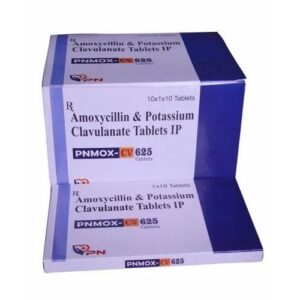CLAVULANATE + AMOXICILLIN
Clavulanate: Clavulanate is a combination drug that contains clavulanic acid, a beta-lactamase inhibitor, and amoxicillin, a penicillin-type antibiotic. It is primarily used to treat bacterial infections that are resistant to conventional penicillin-based antibiotics.
The main function of clavulanate is to inhibit the enzymes called beta-lactamases, which are produced by some bacteria to protect themselves against antibiotics. By inhibiting these enzymes, clavulanate enhances the activity of amoxicillin by preventing bacterial resistance and extends its spectrum of activity.
The recommended dose of clavulanate can vary depending on the severity and type of infection being treated. It is typically available as tablets or oral suspension, and the dosage is often expressed as the ratio of amoxicillin to clavulanate. Common ratios include 250/125 mg, 500/125 mg, or 875/125 mg, with the latter being the standard adult dose.
As with any medication, clavulanate can have side effects. The most common side effects include gastrointestinal symptoms such as nausea, vomiting, stomach pain, and diarrhea. It can also cause allergic reactions in some individuals, ranging from mild skin rashes to severe hypersensitivity reactions. Other possible side effects include headache, dizziness, and yeast infections in women.
It is important to note that clavulanate should only be used under the supervision of a healthcare professional, as it may interact with other medications and have certain contraindications in individuals with specific medical conditions. It is crucial to complete the full course of treatment to ensure the effectiveness of the antibiotic and prevent the development of antibiotic resistance.
Amoxicillin: Amoxicillin is an antibiotic medication used to treat various bacterial infections. It belongs to the class of drugs known as penicillins, which work by inhibiting the growth of bacteria.
The drug is commonly prescribed to treat respiratory tract infections such as pneumonia, bronchitis, and sinusitis, as well as urinary tract infections, skin infections, and certain sexually transmitted diseases like gonorrhea.
Amoxicillin exerts its action by interfering with the bacterial cell wall synthesis, ultimately leading to the destruction of the bacteria. It targets and inhibits the enzymes responsible for constructing the cell wall, which weakens the bacterial cell and makes it more susceptible to destruction by the immune system.
The usual adult dose of amoxicillin is 250-500 mg taken orally every 8 hours. However, the specific dosage may vary depending on the severity of the infection, the patient’s age, and other factors. It is essential to follow the prescribed dosage and complete the full course of treatment to effectively eradicate the infection.
Like any medication, amoxicillin can cause certain side effects. The most common ones include nausea, vomiting, diarrhea, and stomach pain. Other possible side effects may include headache, rash, allergic reactions (ranging from mild to severe, including anaphylaxis), yeast infections, and changes in blood cell counts such as anemia or low platelet count.
It is important to note that amoxicillin may interact with other medications, so it is crucial to inform your healthcare provider about all the medications you are currently taking to avoid any potential interactions or adverse effects.
Overall, amoxicillin is a widely prescribed and effective antibiotic used to treat various bacterial infections. It is important to take the medication as prescribed, complete the full course of treatment, and report any concerning side effects to your healthcare provider.



